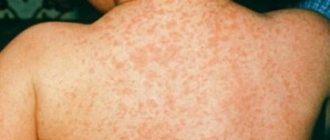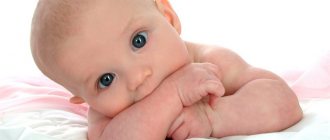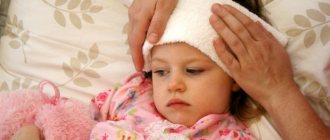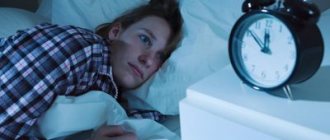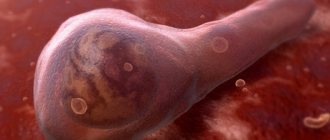Schizophrenia in children is a mental disorder with psychotic symptoms and a chronic course. It manifests itself as a distortion of perception, disruption of associative processes, flattening of affect, emotional coldness, autism, ambivalence of motives and actions.
The main diagnostic methods are clinical, clinical-biographical, and psychological. The basis of pharmacological treatment is drugs from the neuroleptic group. Individual, group and family psychotherapy is carried out, aimed at correcting cognitive deficits and restoring social interaction skills.
Classification and clinical forms
Schizophrenia in children manifests itself in the following forms:
- paranoid (too strong fantasies, delusions, obsessions, anorexia, pathological dissatisfaction with oneself, especially in teenage girls);
- malignant (begins at an early age, is characterized by a sharp predominance of negative symptoms, loss of speech occurs);
- recurrent (hallucinations, delusions, catatonic stupor);
- paroxysmal-progressive;
- sluggish (the most common variant in children, very often the characteristics coincide with special giftedness; such children are ahead of their peers on several points of development and are even considered child prodigies).
Of course, if several signs are detected, you should not draw disappointing conclusions. Teenage girls are characterized by maximalism; they only want to be dazzlingly beautiful and nothing else. They do not yet fully realize that there are no perfect people.
Treatment
Schizophrenia can be treated with medications (antipsychotics) and psychotherapy. The latter happens:
- individual;
- group;
- family.
What is considered effective is a set of corrective measures that compensate for cognitive deficits and help restore communication skills in society.
When seeking medical help in a timely manner, approximately a quarter of patients forget about the attacks forever. Stopping attacks even with a serious degree of development of schizophrenia almost always guarantees a relapse.
Treatment takes place mainly in a hospital, since the behavior of patients is often deviant and threatens not only other people, but also the patient himself.
stabilization occurs - at least five to six months (it is no coincidence that they talk about autumn and spring exacerbations), but sometimes it lasts for a year or even more.
Only attention and support of the patient from family and doctors guarantee long-term remission and reduce the risk of relapse .
The prognosis is favorable only if measures are taken in a timely manner. According to doctors, the most optimistic prospects are for patients whose schizophrenia appeared suddenly.
About the treatment of schizophrenia in children at home and in the hospital in this video:
How to recognize schizophrenia in a child
Even in adult practice, there is no symptom that will clearly indicate whether a person has schizophrenia or not. The specialist always focuses on the totality of symptoms, their development over time and the order of appearance. Against the backdrop of an undeveloped child’s psyche, this is especially important.
Pediatric schizophrenia symptoms and signs are divided into:
- simple - there are no delusions and hallucinations, the leading symptoms are depression of will, motivation and flattening, impoverishment of emotions. Children with this form are very susceptible to treatment;
- hebephrenic - pretentious antics, protest, impulsiveness, aggression towards oneself and others come to the fore. Without treatment, such children are practically unlearnable and dangerous to themselves and others.
- catatonic - children maintain pretentious poses that are given to them, wave their arms or sway, shout or jabber monotonously, flatly refuse to talk, repeat the words, facial expressions, and movements of those around them.
How does schizophrenia manifest in children?
At two years old, the child develops his own speech. Until this point, the main signs are disturbances in the emotional connection with the mother and behavior caused by hallucinations. The child sees or hears what is real only for him and behaves accordingly. The most common manifestation: irrational fears - for example, fear of the color white.
Entering kindergarten is the beginning of an active social life. And here detachment or intrusiveness, helplessness or aggressiveness, advanced or lagging development are manifested. If your child exhibits unusual symptoms, you should see a child psychiatrist who knows how to identify schizophrenia in a child.
Important
The diagnosis cannot be made by one or even several symptoms. Schizophrenia is an insidious disease that can be similar to neurosis, depression, and dementia. Objective diagnosis is possible - for example, using Neurotest.
Before the onset of puberty, the disease progresses in the same way in girls and boys. Psychotic symptoms develop from a child's worldview. The main characters of delusions and hallucinations are toys, folklore characters, and fictional heroes.
Puberty adds appearance and sexuality to potentially painful experiences. The mental development and knowledge base of adolescents is approaching the level of young adults. Therefore, the signs in schizophrenic children aged 12 years and older (depending on the speed of maturation) are close to the classic ones - inadequate ideas on which the child becomes fixated, “voices”, incomprehensible sensations or “visions”. There is excessive attention to appearance (weight loss to the point of anorexia, the desire to correct non-existent physical defects), delusions of other people's parents, obsessive thoughts and actions, inappropriate behavior with aggression, disinhibition of drives, leaving home.
In the absence of treatment and rehabilitation, the onset of the disease distorts the further development of personality and intelligence. In some cases it not only stops, but also regresses. This can happen at 17 or 5 years old.
How is schizophrenia transmitted?
There is no confirmed evidence of the genetic nature of this pathology. There are only versions of how schizophrenia is inherited, based on observations of families with a mental disorder in one (or more) of the relatives. The risk of brain disorders increases if a parent or grandparent is diagnosed with the disease. Multiple cases of the disease in a family significantly increase the likelihood of its development in a child (almost 50%).
Causes of childhood schizophrenia
Scientists have still not been able to identify the exact causes that contribute to the development of the disease both in childhood and in adulthood. The most probable theories of the origin of childhood schizophrenia are considered to be the hereditary theory and neurotransmitter hypotheses.
The theory of inherited transmission of the disease is that the disease can be transmitted from close relatives to children. A family history increases the risk of developing schizophrenia in a child by 12%. However, it is still not known why the disease manifests itself at an early or later age, and what is associated with the appearance of pronounced clinical symptoms closer to adolescence.
Neurotransmitter theories are based on the fact that certain chemical abnormalities occur in the brain, which becomes the basis for the development of the disease.
Pathogenesis
The following developmental mechanisms play a role in the pathogenesis of early childhood schizophrenia:
- oxygen starvation of brain cells, especially affecting the period of growth and development of tissues and organs of the child’s nervous system;
- genetic changes due to toxic effects on the embryo - primarily mutations in the short arm of chromosome 6;
- dysfunction of neurotransmitters - increased activity of dopamine, decreased activity of glutamate receptors.
Signs in babies
In some cases, it is possible to identify obvious mental disorders in a child even before he turns 2 years old. The most noticeable symptoms are strange behavior: for example, a clearly focused gaze literally from birth, as if the child is looking at a non-existent object. And this despite the fact that many babies simply cannot do this.
With the further development of the child, the pathology becomes more and more obvious. A typical sign of schizophrenia is delays in the development of speech and motor skills , although by themselves they do not mean anything. Clumsiness and slowness are very noticeable in their movements; in addition, such children usually do not know how to build interpersonal relationships.
In general, the behavior of the kids seems very eccentric. Their former lethargy, observed in the first months of life, is replaced by slight excitability, a tendency to aggression and screaming, but at the same time - comparative coldness towards their parents. Such a child is capable of getting carried away by his activities to the point of obsession, and in games he usually does not look for company, and generally does not think about the interests of others. Sometimes schizophrenia is accompanied by an oligophrenia-like defect , which is characterized by low memory capabilities and general naivety.
Symptoms and signs of schizophrenia in young children
The exact causes of the disease have not been established. But scientists were able to find out the factors that determine a person’s predisposition to this disorder. At the same time, you cannot be 100% sure, even if everyone agrees that a child may develop schizophrenia, this may not happen.
The disorder appears as a result of violations of the gene structure. Even if a person can live life without complications, his descendants may develop schizophrenia. The disease can be inherited. Completely healthy families are not insured either - the baby may have his own pathology, which will lead to a mental disorder.
The first signs of schizophrenia in children are detected before the age of 2 years. One of the main symptoms is a clearly focused gaze, with the baby looking at objects that do not exist, and this at a time when most babies cannot do this.
There are also counter examples. Against the background of general lethargy, some children may not react at all to moving objects around them. At the same time, they sleep much less time and cry more often, reacting sharply to any noise, which distinguishes them from normal children.
Then the pathology begins to gain momentum. With age, delays in the development of speech and fine motor skills become more noticeable. Movements may become awkward and slow. The child also has problems building interpersonal relationships. There is a lack of attachment to significant adults: parents and other close relatives.
The main points of early childhood schizophrenia can be identified:
- the child’s behavior becomes eccentric, which strongly contrasts with the lethargy of the first months;
- in some cases, schizophrenia is accompanied by the development of oligophrenia and is characterized by low memory capabilities, and the child himself becomes naive;
- after the age of five, hallucinations appear, accompanied by delusions;
- in adolescence, there is a noticeably increased craving for sex, or, on the contrary, a complete suppression of libido; in parallel, various addictions can develop.
Signs of schizophrenia in teenagers
In adolescence, mental disorder manifests itself in detachment from the team. Sick children are reluctant to communicate, have poor contact with peers, are not interested in extracurricular activities, and are not inclined to attend sections and clubs. There is a desire for loneliness. Emotional indifference develops, there are fewer emotions, they are less vivid than in healthy children.
Children with the diagnosis do not study well. They are inclined to believe that they are doing everything worse than others, and to suspect others of having a bad attitude. Old interests are replaced by new, manic ones.
Perception disturbances occur. Auditory and, less commonly, visual hallucinations and delusions may appear. Difficulties arise in distinguishing between reality and dreams and fantasies.
How does the disease manifest itself in children?
A child with schizophrenia begins to withdraw from social life, as his attitude towards people and understanding of reality changes. His personality is undergoing changes.
At the moment of exacerbation of the disease, contact with the world may be completely lost. But social problems arise much earlier than the manifestation of pathology.
The child becomes withdrawn, the team does not interest him, the environment seems hostile to him. He loses interest in his former hobbies that used to give him pleasure.
The disturbances in perception characteristic of this disease lead to the inability to put individual elements together into a coherent whole. It also causes difficulty in isolating the main elements from the overall picture, separating the important and the unimportant.
Children with schizophrenia have a very difficult time distinguishing between dreams and reality. Older children often characterize their condition as living in a dream.
Gradually, behavior begins to change. The child starts talking about things that are strange to the parents, that don’t make sense, display phobias out of the blue, express constant dissatisfaction with their appearance, and invent non-existent diseases.
During the manifestation of the disease, the baby is lost before the appearance of a new, unreal world, where colors, outlines of objects and surroundings change, inspiring horror.
The perception of reality becomes fragmented. With a sluggish disease, such manifestations are less pronounced, and the patient is able to understand what is happening in life and give a description of the pictures.
Childhood schizophrenia is characterized by obsessive states, fixation on unpleasant memories, and a tendency to carry out meaningless rituals.
Speech peculiarities appear in the form of the appearance of new neologisms, a quiet or too loud voice, abrupt phrases, or the rapid pronunciation of incoherent sentences or individual words.
The child sometimes loses the point in a conversation, argues contradictorily, and finds it difficult to answer simple questions.
Emotional deviations arise in the form of selfish worries only about one’s problems, rudeness and aggression towards other people, complete indifference to others and their problems.
A sick child may experience joy and grief at the same time, negativism and reluctance to fulfill requests.
Young children show a tendency to fantasize; they can quickly transform themselves and create invisible participants in games. At school age, the preservation of this ability is a sign of immaturity and mental instability.
What parents should pay attention to
- conflicting judgments;
- difficulties in communicating with others;
- presence of an inferiority complex;
- impaired thinking, inability to adequately answer questions;
- impaired speech (too fast, slow and drawn out);
- association of neologisms;
- lack of intellectual thinking and interest;
- apathy and obsessive states;
- a psyche poor in emotions;
- periodic loss of comprehension of what was said or heard;
- overly emotional perception of failures at school;
- absent-mindedness, aimless existence;
- pathological egoism.
How does autism manifest in childhood schizophrenia?
Previously, autism was considered one of the criteria for schizophrenia in childhood. Currently, this disorder is identified as a separate disease. Autism is a disorder in a child's ability to socially interact. In addition, the pathology is characterized by impoverishment or absence of the emotional background and speech reactions addressed to others. Childhood schizophrenia is often accompanied by signs of autism. However, it is not the only manifestation of the pathology and is mild in severity.
How to identify schizophrenia at an early age?
Diagnostic criteria for childhood schizophrenia are similar to those for adults. The initial stage of the disease is characterized by the following symptoms:
- sleep disturbance, decreased concentration, reluctance to communicate;
- incoherent speech;
- difficulty in learning, inability to achieve the same results as peers;
- the baby hears voices and sees things that are incomprehensible to others;
- lack of logical construction of phrases;
- unmotivated aggression or suicide attempts;
- periodic changes of improvement and deterioration of the condition.
If these symptoms are detected in a child, he must be immediately shown to a doctor, since early detection and timely treatment are the key to a favorable prognosis.
Risk factors
Although the exact cause of schizophrenia is unknown, several factors seem to increase the risk of developing or triggering schizophrenia, including:
- A family history of people suffering from schizophrenia.
- Exposure to viruses, toxins, or malnutrition during fetal development.
- Abnormal activation of the immune system, due to inflammation or autoimmune diseases.
- Old age of the father.
- Use of psychotropic drugs in adolescence.
Symptoms of schizophrenia usually begin in the late teens to mid-30s. Childhood schizophrenia is a rare diagnosis. Early onset schizophrenia occurs in children under 17 years of age. But schizophrenia under the age of 13 is a very rare occurrence.
Treatment of Childhood Schizophrenia.
Since the 1900s, childhood schizophrenia has been recognized as a separate diagnosis - firstly, as a disorder that occurs specifically in children (up to 13–14 years of age); secondly, as a condition that has nothing to do with dementia and other pathologies. Childhood schizophrenia is diagnosed in less than 1% of children.
General description and symptoms
Childhood schizophrenia is a complex mental disorder that affects both the emotional and cognitive processes of the developing personality. Manifestations range from disorganized, weak-willed behavior to paranoia, delusions and hallucinations.
Psychiatrists identify two signs that make it easiest to diagnose childhood schizophrenia:
- Delusions are disordered thinking and groundless, unrealistic beliefs. Hallucinations: the child sees, hears, perceives images that do not actually exist.
- According to statistics, most children with this diagnosis after the age of 11 experience primarily auditory and visual hallucinations. Frequent accompanying symptoms are depression, hearing impairment, and suicidal tendencies.
The tendency to this disorder is inherited from parents and older relatives. Severe stress experienced at an early age can provoke the development of schizophrenia. Viral diseases transmitted even before birth, in the womb, are also cited as causes.
Treatment for a diagnosis of childhood schizophrenia
Like adults, children may be prescribed antipsychotic medications to minimize or even eliminate symptoms. However, it is important to remember that the child’s personality continues to develop. Therefore, treatment is carried out individually and carefully.
Much attention is paid to the qualifications and behavior of the personnel who work with the child; Conduct clear instructions for loved ones who communicate with the little patient. The combined efforts of doctors and families often produce positive results and help the child overcome the disorder, especially in the early stages.
Schizophrenia is a splitting of the soul and mind, which has a pronounced tendency towards chronicity and various forms. This severe mental pathology can manifest itself already in the first year of life, but more often the child population is affected over the age of seven. The cause of schizophrenia remains unclear to this day. It was possible to establish only harmful factors contributing to its development:
- infection,
- intoxication,
- head injury,
- mental shocks,
- pregnancy pathology,
- heredity.
The features of this disease in children under three years of age are expressed in catatonic manifestations. The child is impulsive, excited, walks monotonously in a circle, sways in different directions. He develops unmotivated laughter, often turning into tears. Patients in late preschool age are characterized by a disorder of thought processes. Their unbridled fantasies are divorced from life and fill their entire consciousness. External manifestations may be characterized by indifference and lack of initiative. With the progression of personality changes, after 12 years, not only the hallucinatory-delusional form of the disease is noted. The following serious disorders may occur:
- periods of hypermotor agitation,
- deviations in speech activity,
- immobility,
- speech breakdown.
Pediatric psychoneurology makes every effort to prevent serious complications, including intellectual disability. When children's minds and souls are in harmony, they will know true joy.
Treatment of schizophrenia in children can be outpatient or inpatient (in case of exacerbation). Long-term medical supervision helps prevent the progression of the disease and save the individual from destruction.
Psychiatrists who master modern psychotherapeutic techniques achieve remarkable results in relatively mild forms of the disease. The absence of psychotic episodes, maintaining criticality, and strict adherence to medical instructions make it possible for our patients to visit a psychiatric clinic very rarely. It is enough to come for an appointment once every 2-3 months. If drug therapy is prescribed, doctor visits are more frequent. They are due to the need to write prescriptions, since only if they are available will the pharmacy dispense the drug.
Round-the-clock monitoring by medical personnel is indicated when severe symptoms are detected and the patient lacks control over his actions. Selecting an effective dose of drugs and obtaining positive results may require 2-3 weeks of hospital stay. It is not only the high qualifications and vast experience of doctors that help to successfully stop psychotic manifestations in our clinic. We are equipped with advanced diagnostic and treatment equipment and are constantly exploring innovative ways to restore mental health to children.
In some forms of schizophrenia, we provide young patients with a full life. Severe malignant variants are difficult to treat. And here a lot depends on how timely the therapy began. Drug prevention of personality degradation gradually turns into social rehabilitation of the child. The drugs used are characterized by maximum safety, are easy to use, and are well tolerated by children. Non-drug approaches to solving mental problems are successfully practiced.
The presence of empathic abilities is an important indicator of the professionalism of a physician. Having studied the current scientific literature, doctors are trying to use the valuable function of empathy to interact with the parents of young patients. This allows, against the background of comfortable communication, to identify more significant details that form the symptoms. When everyone unites against the disease, it recedes.
Diagnosis of childhood schizophrenia
Diagnosis of the disorder in children is based on visible symptoms. There are no special clinical methods for detecting the disease. Psychological techniques are used to identify pathology. In addition to them, comprehensive diagnostics include:
- MRI, which allows us to identify changes in the structure of the brain typical of schizophrenia and exclude the presence of possible tumors.
- Electrical encephalography, reflecting a picture of brain activity.
- Duplex scanning of blood vessels, diagnosing the presence of possible diseases - pathologies of venous outflow, atherosclerosis, etc.
- Neurotest, which allows you to track the effectiveness of the functions of the nervous system.
- Laboratory tests for the presence of traces of drugs and the Epstein-Barr virus.
When diagnosing schizophrenia, the method of studying the drawings of patients is used. It is difficult to identify pathology from a drawing alone, but creative work can display possible signs of the disorder. A common symptom of the disease is an unnatural combination of colors: grass is black, clouds are red.
Diagnostics
For diagnosis, specialists use a number of methods :
- clinical;
- clinical and biographical;
- psychological.
The psychiatrist talks with the baby, watches his games, analyzes his actions, way of thinking, drawings .
For the test, the child is asked to draw something on a piece of paper. The plot is usually loose. This is how a little person expresses his experiences , revealing the most characteristic tendencies of the disorder (see photo). The following signs indicate pathology:
- Repetitions of the same elements.
- Images and symbols, certain letters that are not understandable to anyone except the author himself.
- Non-existent animals (cannot draw a single existing one, even schematically).
- Unnatural selection of colors.
- The so-called “drawing within a drawing” depicts, as it were, two plots, one penetrating into the other.
- Unfinished pictures that are not connected to each other.
- Persistent avoidance of one color or another (usually black and red).
The drawing itself will not answer the question of whether the baby is sick or not; it only acts as a kind of indicator of problems in the body.
How to treat?
In addition to basic treatment, the child requires special care (regular feeding, hygiene), and the creation of an emotional atmosphere favorable for him. In particularly difficult cases, with suicidal tendencies or if there is a risk of harm to oneself or others, the child is limited in movement and placed in an isolated room. This requires special permission from the relevant authorities.
Signs of schizophrenia
At a young age, the signs of schizophrenia in a child are practically not clearly expressed - the symptoms are erased and blurred, the disease has an incomplete expression.
However, all symptoms can be roughly divided into the following categories:
- productive symptoms - a pathological process that manifests itself as the pathology develops, manifesting itself in delusional ideas, hallucinations, and pathological forms of fantasy;
- negative symptoms - in this case, the patient loses his psychological qualities as the disease progresses, in particular, interest in the world around him decreases, and emotional manifestations decrease.
We will consider them in more detail.
Negative symptoms
During their development in a child and adolescent:
- Physical activity decreases , emotions become less pronounced and the patient simply immerses himself in his inner world.
- the pathology negatively affects the psychological state of the patient; he develops signs of a mentally retarded child.
- The child’s speech is slurred , thought processes deteriorate, the teenager’s intellectual level drops, and in the worst case, he can behave like an animal, walking on all fours.
This symptomatology is very similar in its manifestations to congenital mental retardation.
Productive disorders
In the patient:
- fear develops;
- retardation in motor function;
- a pathological form of fantasies and delusional ideas is diagnosed;
- anorexia.
So, a child, mostly girls, may feel that he is too fat - refusing to eat and developing anorexia. In boys, negative symptoms most often manifest themselves in excessive rigidity and cruelty, manifestations of rudeness and excessive sexual disinhibition, and a tendency to use drugs and alcohol.
Forecast
The doctor will be able to give an accurate prognosis only after studying the medical history and conducting diagnostics. A mild form or timely detection of the disease usually allows the child to get rid of most symptoms and live a normal life without limiting himself in any way.
With a more serious development of schizophrenia, the child may be deprived of the opportunity to attend a general education institution, since he is capable of harming himself or the people around him. In such cases, he has to learn to write, read and feel at home. Most often, children with such disabilities can communicate normally with people if they receive the necessary treatment.
The main task of parents is to give maximum attention to the child. Children with schizophrenia are especially vulnerable. Therefore, it is necessary to be understanding, be gentle with them and show your love so that they can feel it. If treatment does not produce results and the child shows aggression, you should still adhere to the right position, radiating only goodness.
How does schizophrenia begin?
Schizophrenia often first appears during adolescence, and its first signs can easily be mistaken for teenage negativism. Typically, the disease manifests itself gradually: isolation, inability to act, difficulties in communication, mood swings, loss of vital energy.
In other cases, the disease occurs unexpectedly, due to stress. This happened, for example, with the famous dancer and choreographer Vaslav Nijinsky. The disease arose under the influence of difficult life circumstances, had a difficult course for many years, and then, against the background of joyful experiences, suddenly receded.
An incident from life: a boy, the pride of the school, entered the Faculty of Mechanics and Mathematics at Moscow State University, began studying - and suddenly fell ill and became incapacitated. Impaired thinking, concentration, inability to continue studying.
“The special drama of schizophrenia lies in the fact that the onset of the disease most often occurs during the period of gaining independence from parents, the emergence of romantic relationships, planning education and the beginning of a professional career” De Lisi LE 1992
A patient with schizophrenia, who jumped from a 7th floor balcony and miraculously survived, admits that she tried many times to talk to her mother about her condition, but did not find understanding or support. Perhaps the family thought that the girl was simply fantasizing when she said: “I don’t understand that I am me.” The girl was tormented by strange thoughts: “How can you be happy if we all die later?” She loved to indulge in such thoughts for a long time, lying on the floor.
One of the main problems is the lack of knowledge among relatives and friends surrounding the sick person. If loved ones had paid attention to alarming symptoms in time and consulted a doctor, many tragedies could have been avoided.
Symptoms of the disease fall into three main categories.
- Positive – hallucinations, delusions, mental and motor disorders.
- Negative – loss of motivation, apathy, paucity of speech, asociality.
- Cognitive – disorders of thinking, perception, memory and attention.
Psychotherapy
Psychotherapeutic work with schizophrenic children is successfully and effectively practiced using behavioral models: “token policy”, “intensified correction”, “removal technique”, “payment for misconduct”.
Methods of creative self-expression turned out to be no less effective: elements of art therapy, psychodramatic performances, body-oriented techniques, examples of dance, integrative therapy, as well as other existential methods.
Tips for parents
Raising and living together with a child with schizophrenia is quite a difficult task and requires great willpower and patience. The most important thing parents need to do is accept their son or daughter's diagnosis and believe in the success of therapy.
Here are some expert tips:
- There is no need to argue with your child about his hallucinations. For children diagnosed with schizophrenia, their visions are part of reality;
- try to create a comfortable regime and environment so that the child does not experience unnecessary emotional overload;
- try to protect the child from himself during psychosis.
It is important to diagnose the disease in time and begin its treatment. The future of the child largely depends on this. Therefore, if you notice repeated oddities in a child’s behavior, you should consult a doctor without waiting for the first manifestations of the disease.
Related posts:
- Can dementia be cured at home? Dementia is acquired dementia, a persistent decline in cognitive activity with loss...
- Treatment of schizophrenia with insulin coma - how effective is the method of the past? Schizophrenia is a mental illness that is observed more often than other mental illnesses, usually...
- Symptoms of stress Modern people are almost always in a state of stress. Main source...
- Organic depressive-anxiety disorder Anxiety disorders are a group of neurotic disorders with diverse symptoms….
How to help a child with schizophrenia?
Treatment for schizophrenia should begin immediately after diagnosis. Only a child psychiatrist should prescribe the necessary medications.
A school-age child is prescribed drug therapy in the form of atypical antipsychotics. For severe depression, antidepressants may be used.
Tranquilizers are often used in preschoolers. Insulin therapy and occupational therapy are also used, at the discretion of the physician.
The work of a psychotherapist plays an important role in improving the social adaptation of children.
He not only conducts sessions with the child, but also talks with parents, helping them behave correctly, treat the disease adequately, provide assistance to the baby and create the most comfortable conditions for him to accelerate remission and stabilize his condition.
Rate this article:
(votes: 2 , average: 5.00 out of 5)
Loading...
Related posts:
- What is the difference between fur coat schizophrenia?
- Stages of schizophrenia: how to determine the onset of this mental pathology in time?
- How to promptly recognize the primary symptoms of schizophrenia and help the patient?
- How does a simple form of schizophrenia appear?
- The main signs of schizophrenia in a teenager
- Provoking factors, first and secondary signs of schizophrenia in men
